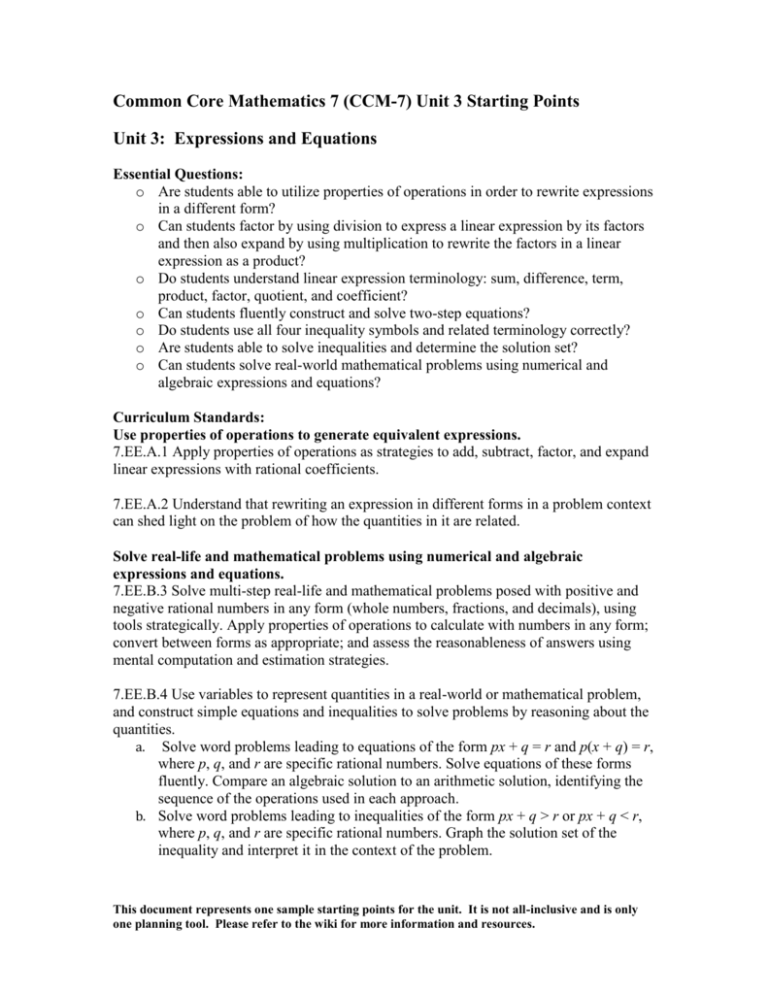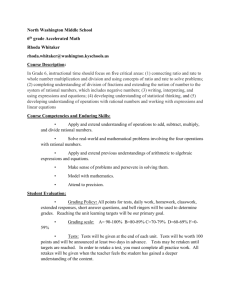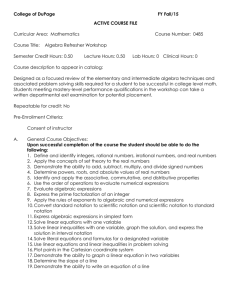Common Core 7 Unit 3 Starting Points
advertisement

Common Core Mathematics 7 (CCM-7) Unit 3 Starting Points Unit 3: Expressions and Equations Essential Questions: o Are students able to utilize properties of operations in order to rewrite expressions in a different form? o Can students factor by using division to express a linear expression by its factors and then also expand by using multiplication to rewrite the factors in a linear expression as a product? o Do students understand linear expression terminology: sum, difference, term, product, factor, quotient, and coefficient? o Can students fluently construct and solve two-step equations? o Do students use all four inequality symbols and related terminology correctly? o Are students able to solve inequalities and determine the solution set? o Can students solve real-world mathematical problems using numerical and algebraic expressions and equations? Curriculum Standards: Use properties of operations to generate equivalent expressions. 7.EE.A.1 Apply properties of operations as strategies to add, subtract, factor, and expand linear expressions with rational coefficients. 7.EE.A.2 Understand that rewriting an expression in different forms in a problem context can shed light on the problem of how the quantities in it are related. Solve real-life and mathematical problems using numerical and algebraic expressions and equations. 7.EE.B.3 Solve multi-step real-life and mathematical problems posed with positive and negative rational numbers in any form (whole numbers, fractions, and decimals), using tools strategically. Apply properties of operations to calculate with numbers in any form; convert between forms as appropriate; and assess the reasonableness of answers using mental computation and estimation strategies. 7.EE.B.4 Use variables to represent quantities in a real-world or mathematical problem, and construct simple equations and inequalities to solve problems by reasoning about the quantities. a. Solve word problems leading to equations of the form px + q = r and p(x + q) = r, where p, q, and r are specific rational numbers. Solve equations of these forms fluently. Compare an algebraic solution to an arithmetic solution, identifying the sequence of the operations used in each approach. b. Solve word problems leading to inequalities of the form px + q > r or px + q < r, where p, q, and r are specific rational numbers. Graph the solution set of the inequality and interpret it in the context of the problem. This document represents one sample starting points for the unit. It is not all-inclusive and is only one planning tool. Please refer to the wiki for more information and resources. Solve real-life and mathematical problems involving angle measure, area, surface area, and volume. 7.G.B.5 Use facts about supplementary, complementary, vertical, and adjacent angles in a multi-step problem to write and solve simple equations for an unknown angle in a figure. Approximate Length of Unit: 35 days Standard(s) 7.EE.A.1 7.EE.A.2 Days 5-6 Notes Big Ideas: Identify properties of addition and multiplication. (Include commutative, associative, identity, multiplicative property of zero, distributive property, additive inverse.) Understand and use properties to generate equivalent expressions. Use variables to represent quantities in the real world. Formulate expressions to represent a scenario in a real-world context. Resources: Lesson: Distributive Property Task: Shop Smart Assessment Limit/Clarification: This standard is part of the major content cluster assessed on PARCC. Assessment Items: PARCC Prototype Item: TV Sales Illustrative Mathematics: Writing Expressions Illustrative Mathematics: Equivalent Expressions? Illustrative Mathematics: Miles to kilometers 7.EE.B.3 7.EE.B.4.a 10-12 Big Ideas: Use variables to represent quantities in the real world. Write equations to represent a given real-world scenario. Construct and solve simple equations (one and two step) including rational numbers. Apply formulas to solve given situations. Reason about the quantity of their solutions. This document represents one sample starting points for the unit. It is not all-inclusive and is only one planning tool. Please refer to the wiki for more information and resources. Resources: Task: Let’s Paint Lesson: Credit Cards Lesson: Introducing Two step equations Assessment Limit/Clarifications: This standard is part of the major content cluster assessed on PARCC and is also a fluency standard. This is a major capstone standard for arithmetic and its applications. Students solve multi-step problems posed with positive and negative rational numbers in any form (whole numbers, fractions, and decimals), using tools strategically. Meeting this standard in its entirety will involve using rational number arithmetic (7.NS.A.1-3) and percents (7.RP.A.3). This standard is part of the major content cluster assessed on PARCC and is also a fluency standard. Work toward meeting this standard builds on the work that led to meeting 6.EE.B.7 and prepares students for the work that will lead to meeting 8.EE.C.7. In solving word problems leading to one-variable equations of the form px+q=r and p(x+q)=r, students solve the equations fluently. This will require fluency with rational number arithmetic (7.NS.A.1-3), as well as fluency to some extent with applying properties operations to rewrite linear expressions with rational coefficients (7.EE.A.1). Assessment Items: PARCC Prototype Item: Spicy Veggies Illustrative Mathematics: Gotham City Taxis Illustrative Mathematics: Shrinking Illustrative Mathematics: Discounted Books Illustrative Mathematics: Anna in D.C. Illustrative Mathematics: Bookstore Account Illustrative Mathematics: Guess My Number 7.EE.B.4.b 7-9 Big Ideas: Use variables to represent quantities in the real world. Write inequalities to represent a given real-world scenario. Construct and solve simple inequalities (one and two step) involving rational numbers. (Introduce negative coefficients.) Graph inequalities on a number line. This document represents one sample starting points for the unit. It is not all-inclusive and is only one planning tool. Please refer to the wiki for more information and resources. Interpret solutions in the terms of the context of the problem. Resources: Lesson: Linear Equations Assessment Limit/Clarification This standard is part of the major content cluster assessed on PARCC and is also a fluency standard. Work toward meeting this standard builds on the work that led to meeting 6.EE.B.7 and prepares students for the work that will lead to meeting 8.EE.C.7. In solving word problems leading to one-variable equations of the form px+q=r and p(x+q)=r, students solve the equations fluently. This will require fluency with rational number arithmetic (7.NS.A.1-3), as well as fluency to some extent with applying properties operations to rewrite linear expressions with rational coefficients (7.EE.A.1). Assessment Items: Illustrative Mathematics: Fishing Adventures 2 Illustrative Mathematics: Sports Equipment Set 7.G.B.5 6-8 Big Ideas: Identify angle relationships. Use facts about angle relationships to write and solve equations to determine an unknown for an angle figure. Resources: Task: Angles in Field Hockey Assessment Limit/Clarification: This standard is considered additional content assessed on PARCC. Students extend their learning in Grade 6 of angle measure, area, surface area, and volume to solve a variety of problems. Howard County Public Schools Office of Secondary Mathematics Curricular Projects has licensed this product under a Creative Commons Attribution-NonCommercialNoDerivs 3.0 Unported License. This document represents one sample starting points for the unit. It is not all-inclusive and is only one planning tool. Please refer to the wiki for more information and resources.









